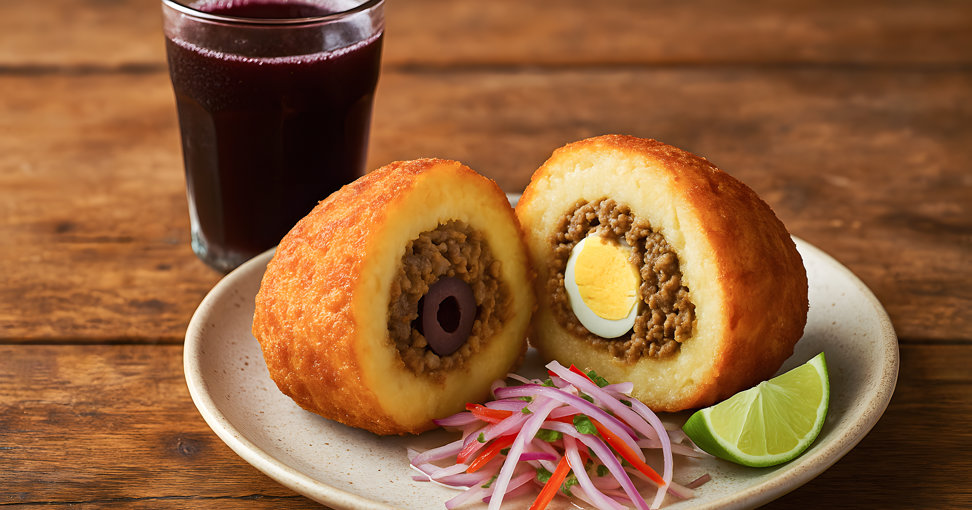Papa rellena, emblematic dish of peruvian cuisine

Papa rellena: a classic of peruvian cuisine
Papa rellena is one of the most iconic dishes of Peruvian cuisine. Its simple preparation, comforting flavor, and versatility have made it a symbol of homemade and popular food in the country. While it is a dish found in several Latin American countries, its Peruvian version has a particular history that intertwines pre-Hispanic, colonial, and even wartime elements.
The millenary origin of the potato
The story of papa rellena begins with the star ingredient of the dish: the potato. This tuber, domesticated more than 7,000 years ago in the central Andes, particularly in what is now Peru and Bolivia, was a staple food for pre-Incan and Incan civilizations. Not only for its nutritional value, but also for its ability to adapt to different altitudes and climatic conditions.
The ancient Peruvians didn’t just consume it boiled or roasted, they also seasoned it with chilies and preserved it in the form of chuño, an ancestral dehydration technique that allowed highland populations to store food for months.
Today, Peru is a global leader in potato biodiversity. It is estimated that there are over 5,000 potato varieties worldwide, with 2,300 registered in Peru alone. This genetic wealth has been key to the development of a wide range of preparations in national gastronomy.
Foreign influence in local cuisine
With the arrival of the Spanish in the 16th century, and later during the Viceroyalty, Peruvian cuisine began to transform. A fusion occurred between native ingredients and European culinary techniques, primarily Spanish, which had themselves been influenced by Arabic cuisine due to centuries of occupation in the Iberian Peninsula.
The use of oil for frying, spice mixtures, and the combination of meat with dried fruits such as raisins are legacies that arrived in the Americas through this cultural chain. Additionally, during the Viceroyalty, African slave labor, mostly women, was introduced, leaving a profound mark on Creole cuisine, adapting local ingredients to their knowledge and customs.
Papa rellena in Peru: between history and tradition
The dish as it is known today—a mashed potato casing filled with seasoned meat, which is then fried to a golden, crispy texture—is the result of this fusion of culinary knowledge.
The traditional Peruvian filling typically includes ground beef, onion, yellow chili, aji panca, black olives, hard-boiled eggs, raisins, and spices such as cumin and pepper. All of these ingredients are enclosed in a layer of mashed potato, which is lightly coated with flour or chuño before being fried in hot oil.
Papa rellena is commonly served as a starter, accompanied by sarsa criolla (pickled red onion with chili and lime), although it can also be served as a main dish, especially when paired with rice. Its flavor and simplicity have made it a constant in family menus, school lunchboxes, patron saint festivals, and street food carts across the country.
A dish of war? The patriotic myth
There is a popular version that places the origin of papa rellena during the War of the Pacific (1879-1883), the conflict between Peru and Bolivia against Chile. It is said that Peruvian soldiers, in need of practical and energizing food, prepared mashed potatoes, which they filled with meat and seasonings, shaped into cylindrical or oval forms, and fried or carried wrapped up, making it easier to transport.
According to this legend, this method of preservation and portability would have been the basis for the modern papa rellena. Although there is no concrete documentary evidence to confirm this, the anecdote has been passed down through oral tradition and is a reflection of how food also becomes part of a nation’s identity narrative.
Variants in Latin America
While each country has adapted this dish in its own way, papa rellena is also popular in Chile, Colombia, Cuba, and Puerto Rico, among other countries. In these places, the filling can vary widely: from pork or chicken to cheese, seafood, beans, or plantains. The covering also changes: some coat it in breadcrumbs, others use yuca instead of potatoes, and some bake it instead of frying.
However, the Peruvian version stands out for the complexity of its seasoning and its deep cultural roots. It is not just a recipe: it is a dish that tells stories, connects generations, and represents the resilience of the Peruvian people.
Papa rellena today: tradition and creativity
Today, papa rellena continues to be a beloved and relevant dish. From homes to gourmet restaurants, it is reinvented with vegetarian, seafood, or regional fillings. There are versions with quinoa, mushrooms, lomo saltado, seco de cabrito, and more. Even contemporary chefs have experimented with its shape and presentation, but without losing its essence: a tribute to the Andean potato and the culinary ingenuity of Peru.
RECIPE
Ingredients:
- 6 white potatoes
- 500 grams ground beef
- 4 garlic cloves
- 1 small onion
- 1 yellow chili pepper
- 1/2 cup of broth
- 50 grams of olives
- 50 grams of raisins
- 2 sprigs of parsley
- 3 hard-boiled eggs
- 1 cup of flour
- Salt, pepper, and cumin to taste
Preparation:
Cook the potatoes, peel them, and while still slightly warm, mash them. Season with salt and pepper and add two egg yolks. Knead until smooth.
Sauté the ground beef with a dressing of chopped onion and minced garlic. Then, add finely chopped yellow chili pepper, chopped parsley, a bit of broth, raisins, chopped hard-boiled egg, and olives cut in half.
Spread a portion of mashed potatoes on a floured surface, place the filling in the center, shape it into a ball or oval. Beat the egg, dip the filled potato in it, and lightly coat with flour.
Fry in hot oil until golden and crispy.
SOURCES:
Book: Cocina Peruana: Historia, Cultura y Sabores, Autor: Sara Beatriz Cuardia USMP
Websites: Peru Travel
Photo: Papa rellena - Restaurante Artesana (Alicante, Spain)